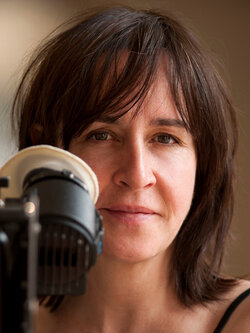Jeanne Lapoirie, AFC, discusses her work with Paul Verhoeven on "Benedetta"
Nuns and Lux, by François Reumont, for the AFCJeanne Lapoirie first met Paul Verhoeven through producer Said Ben Said. "It was a short meeting, less than an hour," she recalls. "I was pretty excited to meet him ! He took me by surprise by speaking to me in English, even though he reputedly spoke very good French. During our conversation, I began to know someone who is very direct and very kind. With his gleaming eye, he immediately began to throw out a few barbs, such as : "You French cinematographers, you don’t light a lot, do you ?" Unexpectedly, the discussion quickly centered on technical questions, such as candlelight and the methods that I might use to fake it. Of course, he mentioned Barry Lyndon, regretting that the eye, in Kubrick’s film, is more drawn to the blinding light of the candle than to the actors. He seemed really concerned about that. It was a bit surprising for me, as I had re-watched several of his film, and expected to talk about his directing and screenwriting, as one does with most directors…"
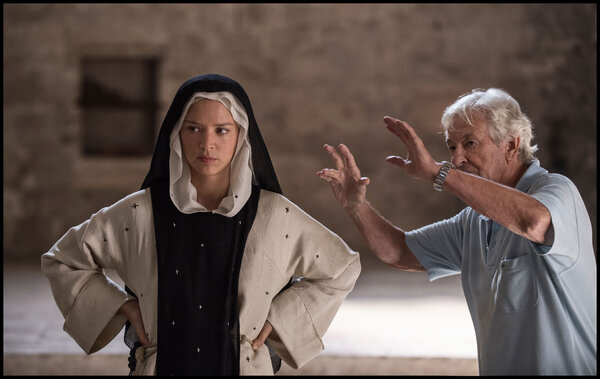
"I tried to reassure him regarding the modern methods of faking candlelight, such as LEDs, and gas strips, which can also work very well sometimes… Especially, I promised him that I wouldn’t only shoot his film using ambient light ! We also discussed handheld cameras, and he wanted to shoot the film using two handheld cameras. I think that he had only seen 120 Beats per Minute, by Robin Campillo, and Mikael Kohlhaas, by Arnaud des Pallières, one of which was shot with two handheld cameras, and the other was a 16th-century period film, the same period as Benedetta. At the end of our meeting, I really wasn’t sure I’d get the job. But, unexpectedly, Virginie Efira let me know the good news a few days later, after she’d had lunch with the producer and the director."
After the first meeting, the scouting work shortly began. This is always a special moment, because one can things concretely and one begins to know the director’s personality, tastes, and desires. This is the beginning of one’s work together, and the time when one can begin to make suggestions : "Only a few film references were mentioned, such as Sergei Eisenstein’s Ivan the Terrible, for the Procession scene ; 8½ by Fellini, and Hitchcock’s films such as North by Northwest. On my own, of course I watched the director’s work over again and I learnt a lot from him : what his style of cinema was, what he liked, how he handled his subjects, shooting, and his actors. I focused primarily on Flesh and Blood, and then watched others of his films. In parallel, as I knew the set designer, Katya Wyszkop, quite well, we had many discussions during location scouting and we began to work together."
"Shooting took place in Summer 2019, in Italy and France. The Dutch director had chosen the small town of Bevagna, located between Florence and Rome, for all the outdoor locations. The rest was shot inside abbeys at Thoronet (Var) and Silvacane (Luberon).
Paul does a lot of planning for each scene. He arrives in the morning with a written shooting script, which includes some drawings. He draws very well. I’ve kept some of those pages. This script gets passed around to the crew, but when Paul saw me in the morning, he would always say, with humor, "Don’t look at it. It’s of no interest. I’m not going to follow it, anyway." At noon, he would redo a script, it would get passed around again, and so on and so forth. He rarely does any master shots, the takes are very short, and this can throw off the actors as they’re often cut short in the middle of their élan : two lines and then cut ! When we suggested he allow them to go on a bit longer, he answered that we weren’t shooting a documentary !
He rarely reshoots a take because of the actors’ performance ; instead, it would be because of the rhythm. He often reread the scenes on the combo, and once I heard him say : "He performs that action 12 frames too late !" But that also has its good sides. Especially on the love scenes, which are very well-prepared, and this put the actresses much more at ease. It’s very far from "go ahead, and let’s see what happens."
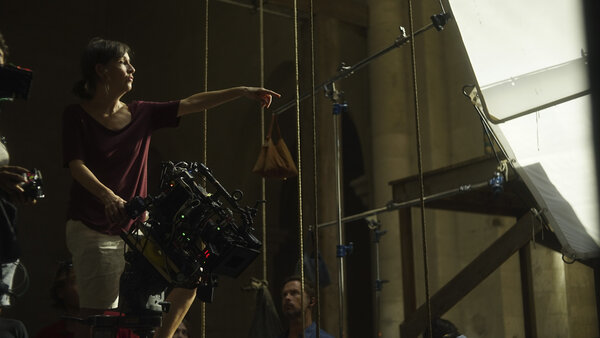
Jeanne Lapoirie also said that the director places great trust in everyone he works with, from the technicians to the actors. Once they’ve been chosen, it’s up to them to make the right choices for the film. As Virgine Efira said : "He said to me in preproduction : ‘You know what you have to do’".
Everyone is free to make his or her own choices within the framework of what has been agreed upon.
For example, he quickly trusted me in terms of lighting, and allowed me carte blanche, without asking me specific questions. I was really able to do whatever I wanted in terms of lighting, at least as concerns the interiors. He also sometimes allowed me to decide what side of the line the gaze would be directed for shot/reverse shots. I must admit that I don’t like having to make that choice, because I’m afraid of putting more emphasis on the lighting than on the rest, and making the scene too conventional, less original and less unexpected. I know that might sound strange, but too much control sometimes gives a flat result. I always feel that my ideas will be less interesting than whatever is caused by chance."
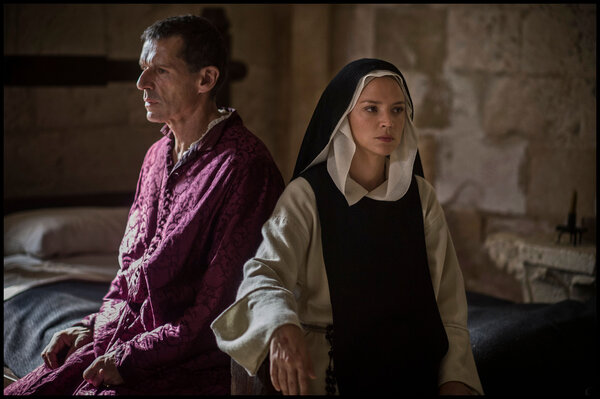
As for the method used to shoot the film, Jeanne Lapoirie chose, as she does on all of her films, to favor zoom lenses (with spherical Angénieux), here, on a handheld camera placed on an EasyRig, with two cameras in the same angle. A Leitz Summilux series was rarely used to complete the panoply for outdoor night scenes.
"It’s true that I try to keep the zooms on the camera as much as I can. Maybe that’s a bit crazy, but I like shooting with the zoom so much that I push the sensitivity as high as it can go, according to our camera tests (1,600ISO), and I even open the shutter up to 300° so that I can rustle a few more lux onto the sensor and avoid having to move over to prime lenses. Sometimes, this was even a subject of disagreement between me and my gaffer."

As for her favorite scenes, Jeanne Lapoirie cites the nighttime interior scenes in the convent, or the comet scene : "On that scene, Paul was apprehensive about the red color. He explained that on Total Recall, he had to redo a series of shots of the set of Mars because everything had come out uniformly red, and blurry, because of the almost-unique wavelength being filmed. I did a few camera tests to check out our setup. On set, the comet’s light was recreated using Arri SkyPanels. For the shots inside of the abbey, we had to hire a company that uses lighting drones. Using a cherry-picker was forbidden (because of the vaults under the floor). The drone was outfitted with a LED lamp, which helped us out a lot during that unique night of shooting."
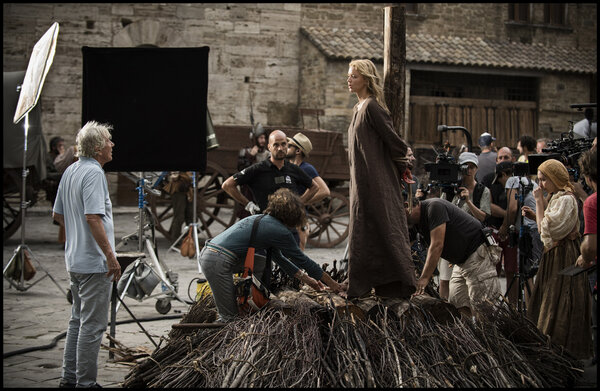
Another challenge on this film : the scene with the burning at the stake, which was shot over the course of five days in a row on the square of the Italian village. "Within a scene, Paul prefers shooting in chronological order as much as possible. He requires that in order to be able to evaluate the rhythm and the editing that will come after. So, I had to figure out solutions in order to ensure continuity, which isn’t easy on an Italian village square outdoors in daytime under the summer sun. I had to install gigantic diffusion fabrics to soften the midday sun and try to take as many bridging shots as I could in the order of the script. When half of the square goes from sunlight to shadow, and back again, many times over the course of the day, you’ve got to be flexible with the camera angles !"
Color grading, too, was performed with the director’s trust. "Since we shot using the LUT I use on all of my projects, the on-set result was very close to the final image. Paul, at the time, was stuck in Los Angeles and couldn’t be there for color grading. After I asked him about it, he didn’t have any particular orders, and he was happy with the image that was already there during editing – and so was I – and therefore the work was pretty simple. We only took two weeks, which is very short for such a heavily cut film. Because I started on 35mm, I have retained an approach to color grading that is similar to color timing, and it doesn’t take such a long time.
What was most complicated during this phase was integrating the effects shots, which have to be reintegrated into the rest – such as the roofs around the convent on the square, which were recreated digitally, the painting showing Jerusalem behind Jesus on the cross, and the red skies with the comet, where we had to synchronize the reds and make it look believable. Paul was mistrustful of digital special effects, and we tried to shoot as much as we could on location. That didn’t spare us from a tripartite shoot for the scene where the nun flings herself from the convent’s roof : Bevagna, for the square outside at night ; the real roof of the abbey ; and a shoot against a green screen.
In the 17th Century, as the plague spreads across Italy, the very young Benedetta Carlini joins the convent of Pescia in Tuscany. From her youngest years, Benedetta has been capable of performing miracles and her presence within her new community will change many things in the sisters’ lives.
(Interview by François Reumont translated from French by A. Baron-Raiffe, for the AFC.)
 En
En Fr
Fr
